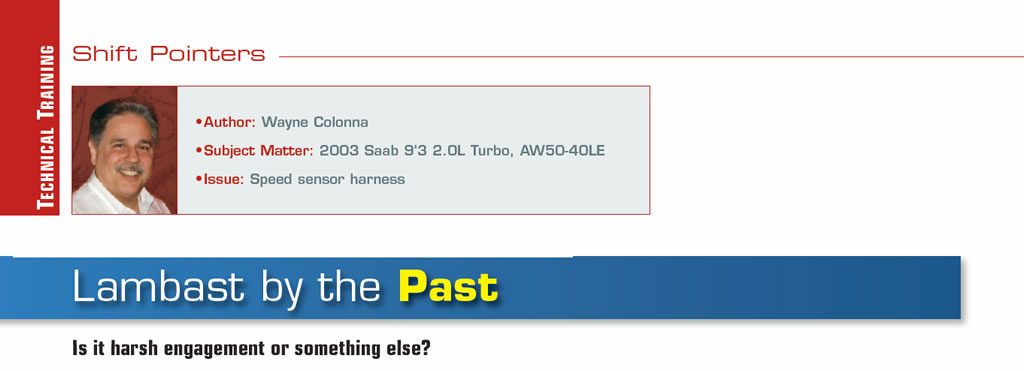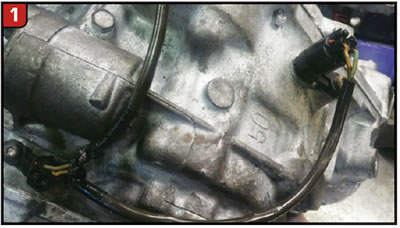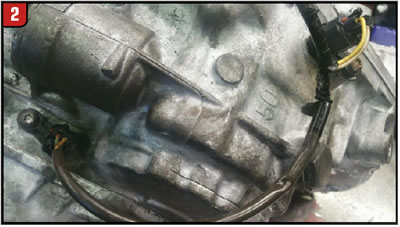
Shift Pointers
- Author: Wayne Colonna
- Subject Matter: 2003 Saab 9’3 2.0L Turbo, AW50-40LE
- Issue: Speed sensor harness
Is it harsh engagement or something else?
Anthony Nuzzo, the owner of Accord Transmission & Differential, originally gave us a call on a 2003 Saab 9-3 2.0L Turbo, using the AW50-40LE transmission that was experiencing a harsh engagement into reverse when hot. His tech Pete Morreale was out on vacation so Anthony was handling the diagnostics, making him quite a busy man.
There can be more than one cause producing this type of complaint. The place to start is to understand what occurs when reverse is selected.
The underdrive brake band (B4) applies immediately when the vehicle is started. When the selector lever is moved into reverse, the direct clutch (C2) and the L/R clutches (B3) apply.
Whenever you apply two components at the same time to achieve a smooth engagement, the brake clutch (B3) should apply slightly before the driving clutch (C2). If the driving clutch applies before the brake clutch, the driving clutch will spin the gear train. When the brake clutch applies, it will jolt the gear train to a stop, producing what feels like a harsh engagement.
Timing is controlled hydraulically in conjunction with clutch clearances. With this particular transmission, the B3 clutches are applied from pressure coming off the manual valve while the C2 clutch apply pressure is orifice controlled going to the C2 accumulator valve and C2 accumulator piston. The idea again is to bring the B3 clutches on slightly before the controlled apply of the C2 clutches.
For obvious reasons, excessive B3 clutch clearance can contribute to a harsh reverse engagement. The C2’s will have a chance to spin the gear train just slightly before the engagement of the B3. Likewise, a compromised C2 accumulator valve or piston can produce the same result.
And then there is line pressure, which is electronically and hydraulically controlled. Anything from a computer command to performance malfunctions can produce too high of line slamming the clutches on. A simple line-pressure check is all that is needed to determine if there is a pressure problem or a timing problem.

A few other possibilities to keep in mind would be bushing wear, gear train clearances and fluid-to-friction compatibility. These possibilities are usually accompanied with other complaints.
All this was explained to Anthony, making his first step to check line pressure. When he had, it was according to specifications (base line in reverse is 85-100 psi). The unit came back out and all clutch clearances were checked and corrected. End play clearances and bushing wear were inspected and corrected. The C2 accumulator valve and piston were checked, cleaned and refreshed.
The unit went back into the car, and when they placed the selector lever into reverse, the harsh engagement was no longer the problem as there was NO reverse. Uh-oh, what did they do wrong inside the transmission? Some may see this as progress seeing there was not a harsh engagement. The problem is the customer may not agree. Anthony asked his R & R guy if the speed sensors were swapped. His reply was that it couldn’t as the wires will not reach. With that answer, the decision was made to pull the unit. And this is what Pete came face to face with when he returned from his vacation, the transmission on the bench with no reverse after others were already into it to fix a harsh reverse.
He disassembled the unit and found no reason for this to not have reverse. And to Pete’s credit, having heard Anthony mentioning speed sensors to him, he called here and asked us about if the speed sensors were swapped, could it cause a no reverse condition? The answer to his question was yes.
Whenever you have a computer strategy that is able to prevent a reverse engagement should the selector lever be moved into reverse while the vehicle is moving forward, speed sensor signals are in play. The strategy with this transmission is if reverse is engaged when the vehicle is going 4 mph and above, the S1 solenoid turns on, which will cause the 1-2 shift valve to close blocking fluid pressure from applying the B3 clutches. When the speed sensors are installed onto the transmission backwards, the OSS is reading the ISS signal upon initial startup. The computer sees this as a vehicle speed high enough to prevent a reverse engagement. Had the transmission been placed into drive with the brake applied, the ISS reading would have gone to 0 rpm. A reverse engagement would then be possible from the drive position – a quick and simple way of identifying the problem.

This is a problem many of us have seen years back with a variety of transmissions. Particularly with transmissions that would allow the speed sensor harness to come out with the transmission. After the rebuild, it is really easy to install the harness back onto the transmission incorrectly (Figure 1). With this transmission, the green and yellow/blue wire sensor is the ISS while the yellow and grey wire sensor is the OSS (Figure 2). As you can see by the photos, if the harness runs up toward the servo, it is backwards. When it runs across the back cover, it is installed correctly. Since most transmissions coming into the shop these days do not have this issue, it’s easy to experience lambast by the past.

When the vehicle finally had reverse, it was proven that a timing problem existed, causing the reverse engagement complaint.














